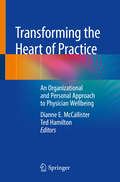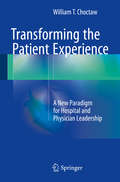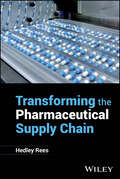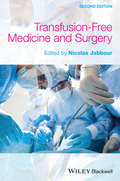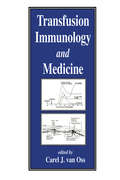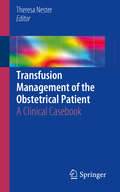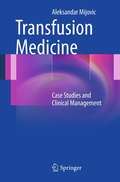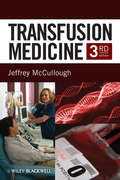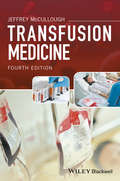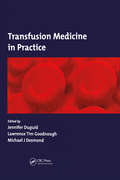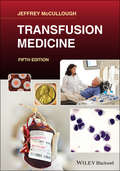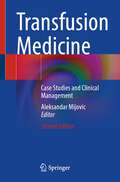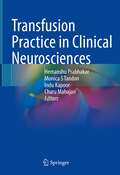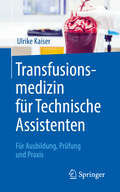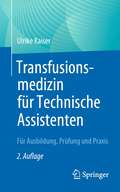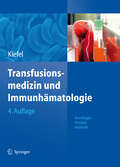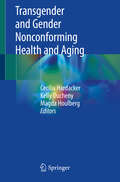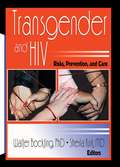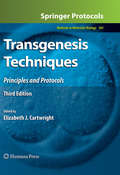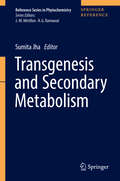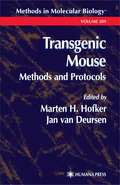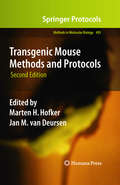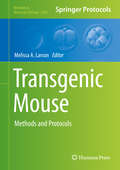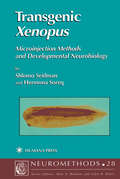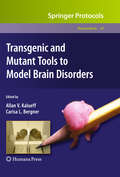- Table View
- List View
Transforming the Heart of Practice: An Organizational and Personal Approach to Physician Wellbeing
by Dianne E. McCallister Ted HamiltonThis unique, step-by-step guide offers a comprehensive exploration of burnout and physician wellbeing, a vital issue that steadily has become widely discussed in the professional and mainstream press. More than twenty chapter authors contribute to this multidimensional volume, including physicians, psychologists, researchers, healthcare administrators, chaplains, professional coaches, and counselors. Section one of the book establishes context, provides a brief overview of the phenomenon of physician burnout, establishes its validity, and makes a case for the reason it has emerged as a critical issue in American healthcare. Section two provides a rationale for healthcare institutions (hospitals, physician groups, medical associations) to make a commitment to physician wholeness, while section three then starts the process of delineating a step-by-step curriculum to address the dilemma, providing additional detail and personal experience direct from the frontlines of combatting burnout. Section four focuses on developing and sustaining a healthy professional culture that is aligned with the mission of the organization, and section five addresses the spiritual component of physician wholeness, Section six concludes the book with two personal essays that poignantly express the nature of two common experiences affecting physicians that require uncommon insight, patience, courage. Transforming the Heart of Practice is a major contribution to the literature and will serve as an invaluable resource for anyone concerned with addressing this crisis in American healthcare.
Transforming the Patient Experience
by William T. ChoctawThis book provides an organizational model of the common ground needed to improve patient care and adapt to today's healthcare environment. The relationship between a hospital CEO and a general surgeon and how they aligned, motivated and partnered with physicians to change the culture of a hospital and implement patient oriented systems is the essential element of this text. Sustainable transformation processes will also be presented for the various roles and contributions of the healthcare team. Written from a team perspective, Transforming the Patient Experience is a practical guide for healthcare team members and leaders to follow.
Transforming the Pharmaceutical Supply Chain
by Hedley ReesEffective and insightful solutions to the most pressing supply chain challenges facing pharmaceutical companies today In Transforming the Pharmaceutical Supply Chain, veteran biotech supply chain strategist, Hedley Rees, delivers a reasoned and systematic solution to the most widespread and relevant challenges in the pharmaceutical supply chain. The book explains the deeply rooted issues within pharma supply chains and the modus operandi of the industry while also discussing effective solutions to the underlying causes that led to widespread system breakdown. The author applies modern methods of product development and commercial supply successfully used by leaders in the field. He provides real-world examples of ways to make the delivery of medicines to patients efficient and effective. Readers will also find: A clear explanation of the development, manufacture, and delivery of drugs to patientsComprehensive explorations of the issues and challenges to the current supply chain system paired with effective solutionsExpert witness accounts, anecdotes, case studies and examples of pharmaceutical supply chain difficulties and solutionsComplete treatments of how to adapt supply chain techniques to a pharmaceutical era dominated by biologics and advanced therapies Perfect for pharmaceutical and biopharmaceutical professionals working in drug development, Transforming the Pharmaceutical Supply Chain will also benefit industry professionals with a responsibility for the logistics, commercial supply, manufacturing, regulation, quality management, finance, and marketing of pharmaceuticals.
Transfusion Free Medicine and Surgery
by Nicolas JabbourThis book aims to be a guide to the practice of blood conservation. The first chapter discusses the legal and administrative aspects of bloodless medicine describing the legal principles and practical issues relatd to refusal of transfusion. The second is on balancing the risks and benefits of transfusion includes clinical vignettes of appropriate and inappropriate transfusion. The remainder of the book covers the principles and practice of bloodless medicine, including a chapter on the scientific issues of haemostasis and the investigation of bleeding idsorders. The book concludes with chapters on blood conservation in neonatal and paediatric surgery, the costs associated with blood transfusion and the quest for artifical blood. New chapters will be included to address blood utilization in oncology and geriatric patients.
Transfusion Immunology and Medicine
by Carel J. van OssBased on the proceedings of the International Convocation on Immunology held recently at the State University of New York at Buffalo, this up-to-date resource provides a state-of-the-art examination of blood transfusion practice and its future possibilities.Explains the immunological effects of blood transfusion as well as its immunological and
Transfusion Management of the Obstetrical Patient: A Clinical Casebook
by Theresa NesterThis clinical casebook covers transfusion medicine theory and its practical implications for the obstetrical hemorrhage patient through the presentation of cases on actively bleeding patients. Each case features a unique clinical scenario involving a bleeding patient and outlines different aspects of safe and effective transfusion support. The cases contain current evidence on the latest topics in the field, such as the use of antifibrinolytic agents and coagulation factor concentrates in the setting of massive obstetrical hemorrhage. In addition to the actively bleeding patient, the casebook includes other important management topics, including the role of plasma exchange in thrombotic microangiopathies during pregnancy; treatment of hyperhemolysis in a patient with hemoglobinopathy; and recommended management of patients with red cell antibodies found on prenatal testing. Other immunohematology topics such as post-natal management of an RhD negative woman for the prevention of hemolytic disease of the newborn due to anti-Rh(D) are included.Written by transfusion medicine, coagulation, obstetrical, and anesthesiology experts, Transfusion Management of the Obstetrical Patient: A Clinical Casebook is a concise yet comprehensive resource for anesthesiologists, obstetricians, pathologists, hematologists, and other practitioners who treat obstetrical hemorrhage patients.
Transfusion Medicine
by Aleksandar MijovicThe purpose of this clinical transfusion medicine handbook is to take the reader through a variety of clinical problems, each one likely to be encountered in a busy teaching hospital. The reader follows the stream of clinical and laboratory data, developing the ability for critical thinking which leads him/her to diagnosis and appropriate management. The book is a lively illustration of various clinical problems in transfusion medicine, including immune complications, microbiological problems, blood component use, apheresis techniques, and management of complex situations such as multiple trauma, sickle cell crisis, and organ transplantation. Each case is carefully chosen and presented, with incorporated questions, leading the reader towards solution of the problem in a logical and didactic manner
Transfusion Medicine
by Jeff McculloughTransfusion Medicine offers a concise, clinically focused and practical approach to this important area of medicine.This well-known handbook presents the experience of a world leader in the field of blood banking and transfusion therapy. Transfusion Medicine offers complete guidance on the full range of topics from donor recruitment, blood collection and storage, to testing and transfusing blood components, complications and transmissible diseases, as well as cellular engineering, therapeutic apheresis, and the role of hematopoietic growth factors.This third edition includes updated information on a number of areas including:Current debate on clinical effects of stored red blood cellsEmerging infectious diseases and impact on blood safetyNew concepts of massive transfusionWorld blood supplyPlatelet transfusionPathogen inactivationTransfusion Medicine will be valuable to all those working in the field of blood banking and transfusion. It is a good introduction to transfusion for hematology or oncology fellows and technologists specialising in blood banking.
Transfusion Medicine
by Jeffrey McculloughTransfusion Medicine provides a concise, clinically focused and practical approach to the field of blood banking and transfusion therapy written by international expert, Jeffrey McCullough MD. Concise, approachable, yet comprehensive approach to the field of transfusion medicine and blood banking Offers extensive guidance on important topics such as; donor recruitment, blood collection and storage, donor testing and clinical uses of blood components, techniques of administration of blood components, complications of transfusion, transmissible diseases, the HLA system, and many more Provides new content on patient blood management systems, the changing indications for red cell transfusion, new transmissible disease agents, management of massive blood loss, pathogen reduced blood components, therapeutic apheresis including photopheresis, management of massive transfusion and new cellular therapies. Discusses global blood supply and US blood supply organizations and their consolidation and reorganization Reviews other topics of current interest, such as mitigation strategies for TRALI prevention, effects of storage of blood on adverse effects, management of massive blood loss and massive transfusion protocols pathogen inactivation, and granulocyte transfusion Extensively referenced for further study
Transfusion Medicine in Practice
by Jennifer Duguid, MB, FRCPathTransfusion Medicine in Practice focuses on the clinical applications of transfusion, discussing the different settings in which transfusion is carried out, including surgery, transplant, trauma, intensive care, and paediatric neonatal and obstetric cases. The text also includes a full discussion of transfusion products and how to use them, pharmacologic products as an alternative to blood, and transfusion service management. This practical text on the clinical practice of transfusion will be an invaluable resource for all those involved in the use of blood and blood products.
Transfusion Medicine: A Practical Guide
by Jeffrey McCulloughExplore this concise and clinically focused approach to the field of blood banking and transfusion therapy The Fifth Edition of Transfusion Medicine delivers a succinct, thorough, clinically focused, practical and authoritative treatment of a full range of topics in transfusion therapy. This ranges from issues with the blood supply, recruitment of both whole blood and apheresis donors, blood collection and storage, blood testing, blood safety, and transmissible diseases. This edition has been fully updated and revised to include exciting cellular therapies for cancer, transplantation of both hematopoietic cells and solid organs, infectious diseases and regenerative medicine. The Fifth Edition includes new authors with highly relevant content that provides a solid grounding for readers in the field. The book: Is an approachable comprehensive guide to the field of blood banking and transfusion medicine Provides complete and timely perspective on crucial topics, including the HLA system in transfusion medicine and transplantation and quality programs in blood banking and transfusion medicine Is extensively referenced, making it simple for readers to conduct further research on the topics of interest to them Includes new chapters on pediatric transfusion medicine and pathogen reduction Has an expended chapter on patient blood management Provides extensive discussions of the clinical use of blood transfusion in a wide variety of clinical situations including recent development In the management of acute traumatic blood loss Provides updated information about blood groups and molecular testing making inroads into clinical practice along with discussions of laboratory detection of blood groups and provision of red cells Perfect for all those working in the field of blood banking, transfusion medicine and hematology or oncology and fellows in pathology, hematology, surgery and anesthesiology. Transfusion Medicine is a good introduction for technologists specializing in blood banking and non-medical personnel working in areas related to hematology and transfusion medicine. Transfusion Medicine will also earn a place in the libraries of practicing pathologists with responsibility for blood banks.
Transfusion Medicine: Case Studies and Clinical Management
by Aleksandar MijovicThis thoroughly revised and updated case-based book describes a variety of clinical scenarios in transfusion medicine likely to be encountered in a busy teaching hospital. It highlights the stream of clinical and laboratory data available to transfusionists, while reviewing the critical thinking required to lead the decision-making process towards accurate diagnosis and appropriate management.Transfusion Medicine: Case Studies and Clinical Management is a lively illustration of various clinical problems in transfusion medicine, including immune complications, microbiological problems, blood component use, apheresis techniques and management of complex situations, such as multiple trauma, sickle cell crisis and organ transplantation. Each case is carefully chosen and presented, with incorporated questions leading the reader towards solution of the problem in a logical and didactic manner. It is therefore essential reading for all medical and scientific professionals involved in managing transfusion, from hematologists to obstetricians, surgeons, intensivists and immunologists.
Transfusion Practice in Clinical Neurosciences
by Hemanshu Prabhakar Charu Mahajan Indu Kapoor Monica S TandonFluid management is the basis of all clinical management in neurosurgical patients. This is a complete book on transfusion practice in clinical neurosciences. It covers in detail the fluids and blood transfusion practice, also discussing the role of total parenteral nutrition in relation to neurologic patients. The importance of fluid management clinically can be seen as on one hand it plays a significant role in maintaining the hydration of the patient and on the other provides sufficient relaxation to the brain to facilitate surgery. The use of hyperosmolar therapy is unique to the practice of clinical neurosciences. Certain fluid types such as those containing glucose are detrimental to the brain. Likewise, large fluid shifts and blood loss are often observed during neurosurgical procedures. It is relevant to understand the physiology of blood and blood transfusion. This book covers all of these topics in their true relevance. It also provides an evidence-based practice of fluid administration for all neurologic patients including, pediatric and geriatric. The proposed book will be useful for trainees and clinicians in any field of clinical neurosciences. It would be very useful for residents and fellows pursuing their courses in neuroanesthesia, neurocritical care, neurosurgery, emergency medicine, anesthesia, and critical care. Fellows, Resident doctors, postgraduates, and even undergraduates would be benefited from this book. The book would be a ready-reckoner and useful during the clinical practice of physicians from varied specialties.
Transfusionsmedizin für Technische Assistenten: Für Ausbildung, Prüfung und Praxis
by Ulrike KaiserIn dem vorliegenden Werk findet sich das Wesentliche zur Transfusionsmedizin und Immunhämatologie - leicht verständlich, sehr übersichtlich und mit vielen wertvollen Tipps aus der Praxis, speziell zugeschnitten auf die Bedürfnisse von MTAs, wie MTLAs, MTRAs, MTAFs sowie CTAs und BTAs. Das Werk eignet sich hervorragend als Begleitbuch im Rahmen der Ausbildung und zur Vorbereitung auf die Prüfung sowie für den schnellen Überblick im Berufsalltag. Aus dem InhaltGrundlagen und BiochemieBlutgruppensystemeTestverfahrenBlutprodukteKlinik und Krankheitsbilder
Transfusionsmedizin für Technische Assistenten: Für Ausbildung, Prüfung und Praxis
by Ulrike KaiserIn dem vorliegenden Werk findet sich das Wesentliche zur Transfusionsmedizin und Immunhämatologie - leicht verständlich, sehr übersichtlich und mit vielen wertvollen Tipps aus der Praxis, speziell zugeschnitten auf die Bedürfnisse von MTAs, wie MTLAs, MTRAs, MTAFs sowie CTAs und BTAs. Dargestellt werden u.a. die Blutgruppensysteme, Testverfahren, Blutprodukte sowie unerwünschte Wirkungen, Nebenwirkungen und Komplikationen der Transfusion. Das Werk eignet sich hervorragend als Begleitbuch im Rahmen der Ausbildung und zur Vorbereitung auf die Prüfung sowie für den schnellen Überblick im Berufsalltag. Die 2. Auflage erscheint aktualisiert.
Transfusionsmedizin und Immunhämatologie
by Christian Müller-Eckhardt Volker KiefelSystematisch aufgebaut und klar strukturiert stellt das Standardwerk das Gebiet der Transfusionsmedizin und Immunhämatologie in seiner Gesamtheit dar: von den Grundlagen der Transfusionsmedizin, der Therapie mit Blut, Blutkomponenten und Blutbestandteilen über Blut sparende Maßnahmen bis hin zu unerwünschten Wirkungen von Blutübertragungen. Das einzige deutschsprachige Werk zu diesem Fachgebiet wurde für die 4. Auflage komplett aktualisiert und erweitert. Der Anhang enthält Nachweise für alle relevanten Antigene und Antikörper.
Transgender and Gender Nonconforming Health and Aging
by Cecilia Hardacker Kelly Ducheny Magda HoulbergThis text addresses the specific lack of clinical educational support for transgender and gender nonconforming (TGNC) individuals as they age. Chapters are written by multidisciplinary healthcare experts who present topical discussions in five critical areas: essential foundational information needed to understand the life experience of older TGNC people; mental and behavioral health issues; social service considerations; specific concerns for nurses; and unique long-term medical concerns for providers. In addition, special attention is placed on providing care for TGNC veteran populations, including strategies to access social services and Social Security, and developing support networks.Transgender Health and Aging is an excellent resource for clinical and research professionals from a variety of medical disciplines, including geriatricians, primary care physicians, psychiatrists, public health officials, social workers, nurses as well as nonprofessional audiences interested in transgender healthcare in older adults.
Transgender and HIV: Risks, Prevention, and Care
by Edmond J Coleman Walter O Bockting Sheila KirkDeliver effective services to this growing population! This volume presents the first collection of reports on the impact of HIV/AIDS on the transgender community worldwide. It includes a thorough description of the unique HIV risks of transgender people and exposes their largely neglected health and social service needs. This unique book also reports on the first generation of prevention interventions targeting this community, discusses guidelines for providing sex reassignment services to HIV-positive transsexuals, and encourages collaboration between communities at risk, researchers, and people in the helping professions.The social stigma faced by this population adds to their risk of HIV infection. Low self-esteem, rejection, neglect, employment discrimination, disenfranchisement, and a desire for acceptance and validation are all contributing factors. Yet, as the editors point out, “On the positive side, the transgender community has been able to mobilize and empower itself, and has found a voice that no longer can be ignored. We call on transgender and nontransgender people alike to work together to advance HIV prevention and promote our sexual health.”In Transgender and HIV you'll encounter: extensive discussions of the health, social service, and HIV prevention needs of the transgender community tips on how to work with marginalized communities in an empowering way explorations of the sexuality of both male-to-female and female-to-male transsexuals first-ever findings on sex reassignment surgery on HIV-positive individuals guidelines for surgery on HIV-positive transsexualsTransgender and HIV provides much-needed and often-requested information on HIV prevalence, risks, prevention, and care for this increasingly visible community.
Transgenesis Techniques
by Elizabeth J. CartwrightOne of the major challenges currently facing the scientific community is to understand the function of the multitude of protein-coding genes that were revealed when the human genome was fully sequenced. In Transgenesis Techniques: Principles and Protocols, Third Edition, experts in the field fully update and expand upon the previous edition in order to detail the transgenic techniques currently used to modify the genome. The volume explores classic procedures to genetically modify mice and other model organisms, as well as cutting-edge practices involving microinjection, site-specific recombination systems, cryopreservation, and many other topics. Written in the highly successful Methods in Molecular BiologyTM series format, the chapters include brief introductions to their subjects, lists of the necessary materials and reagents, step-by-step, readily reproducible laboratory protocols, and notes sections, highlighting tips on troubleshooting and avoiding known pitfalls. Comprehensive and state-of-the-art, Transgenesis Techniques: Principles and Protocols, Third Edition is a comprehensive practical guide to the generation of transgenic animals and an invaluable source of information in any lab currently involved in transgenic techniques.
Transgenesis and Secondary Metabolism
by Sumita JhaThis handbook provides comprehensive reference information on the efficient production of secondary metabolites from plants by transgenesis and other genetic manipulation strategies. It reviews and summarizes selected important case studies in genetic methods applied to enhance the production of a given metabolite or a group of related or derived compounds. Readers will find reference information on a multitude of techniques and methods, including traditional breeding and screening; over-expression of genes encoding key enzymes; functional genomics approaches; metabolic engineering of the relevant biosynthetic pathways; indirect genetic approaches to improve metabolite production, including Agrobacterium mediated transformations. Furthermore, combinatorial biochemistry approaches to engineer secondary metabolic pathways are summarized, which can offer access to new structures or to the design of novel compounds. Since many commercially valuable substances are still extracted from plants, being largely inaccessible to efficient modern laboratory synthesis methods, this book provides a valuable resource of information for biotechnological approaches that can help to find alternative and more efficient methods for the production of natural secondary metabolites. Thus adjusted production methods, with the help of tailored plant systems, can potentially help to release the stress on plants, which are currently suffering from extensive human harvesting, and to conserve global biodiversity. Readers will find comprehensive reference information on plant genetic manipulation toward more efficient synthesis, accumulation and production of target secondary metabolites. The handbook will appeal to researchers and professionals, but also graduate students and scholars working in the fields of biotechnology, genetic engineering, medicinal plant research, pharmacy, and phytochemistry.
Transgenic Mouse Methods and Protocols
by Marten H. Hofker Jan Van DeursenMarten Hofker and Jan van Deursen have assembled a multidisciplinary collection of readily reproducible methods for working with mice, and particularlyfor generating mouse models that will enable us to better understand gene function. Described in step-by-step detail by highly experienced investigators, these proven techniques include new methods for conditional, induced knockout, and transgenic mice, as well as for working with mice in such important research areas as immunology, cancer, and atherosclerosis. Such alternative strategies as random mutagenesis and viral gene transduction for studying gene function in the mouse are also presented.
Transgenic Mouse Methods and Protocols, 2nd Edition
by Marten H. Hofker Jan Van DeursenMarten Hofker and Jan van Deursen have assembled a multidisciplinary collection of readily reproducible methods for working with mice, and particularlyfor generating mouse models that will enable us to better understand gene function. Described in step-by-step detail by highly experienced investigators, these proven techniques include new methods for conditional, induced knockout, and transgenic mice, as well as for working with mice in such important research areas as immunology, cancer, and atherosclerosis. Such alternative strategies as random mutagenesis and viral gene transduction for studying gene function in the mouse are also presented.<P><P> Fully updated from the first edition to offer cutting-edge methods for generation of transgenic mouse models
Transgenic Mouse: Methods and Protocols (Methods in Molecular Biology #2066)
by Melissa A. LarsonThis volume provides readers with a historical foundation in standard techniques and a comprehensive update on the latest methods used in making gene-modified mice. The chapters in this book cover topics such as pronuclear microinjection in one-cell embryos; embryo transfer surgery; nuclear transfer and cloning; blastocyst microinjection; and cryobanking and recovery of genetically modified mice. Importantly, there are chapters devoted to the latest application of CRISPR technology, as well as the establishment of induced pluripotent stem cells. Written in the highly successful Methods in Molecular Biology series format, chapters include introductions to their respective topics, lists of the necessary materials and reagents, step-by-step, readily reproducible laboratory protocols, and tips on troubleshooting and avoiding known pitfalls.Comprehensive and authoritative, Transgenic Mouse: Methods and Protocols is a valuable resource for both novice and expert researchers who are interested in learning more about this evolving field.
Transgenic Xenopus
by Shlomo Seidman Hermona SoreqTwo distinguished international experts offer a fully illustrated, thoroughly referenced guide to the use of microinjected Xenopus embryos to study the role and spatiotemporal regulation of nervous system proteins during vertebrate development. Drs. Seidman and Soreq include all the basic scientific background and protocols needed to consider and exploit the vast potential of this model system. They provide an outline of Xenopus development, detailed methods for in vitro fertilization and microinjection, and protocols and references for a variety of biochemical and histochemical techniques to analyze the results of a microinjection experiment. They also present extensive experimental data illustrating the use of enzyme activity assays, gel electrophoresis, density ultracentrifugation, EAIA, RT-PCR, cytochemical and immunocytochemical staining, and electron microscopy. Transgenic Xenopus demonstrates convincingly the special utility of Xenopus embryo microinjection as a sophisticated and versatile tool for studying nervous system proteins.
Transgenic and Mutant Tools to Model Brain Disorders
by Allan V. Kalueff Carisa L. BergnerAs the presence of genetically modified animal models in research laboratories has multiplied, the role of genetic factors in the pathogenesis of brain disorders has become particularly important. The refinement of molecular genetic methods has continued to broaden our understanding of the genetic factors associated with a variety of disorders. In "Transgenic and Mutant Tools to Model Brain Disorders", leading scientists specializing in this field contribute a timely collection of recent advances featuring a vast array of topics in order to contribute to the diverse approaches taken toward the evaluation of genetically modified models in biomedical research. Opening with several chapters covering general aspects of genetically modified animal models, the book then continues with detailed chapters on models of specific human brain disorders, including OCD, Rett Syndrome, anxiety disorders, depression, and schizophrenia. As a volume in the successful NeuromethodsTM series, the chapters provide authoritative reviews covering the most commonly used approaches in the field. Cutting-edge and concise, "Transgenic and Mutant Tools to Model Brain Disorders" offers a comprehensive and descriptive overview on a variety of topics in neuroscience and biological psychiatry.
